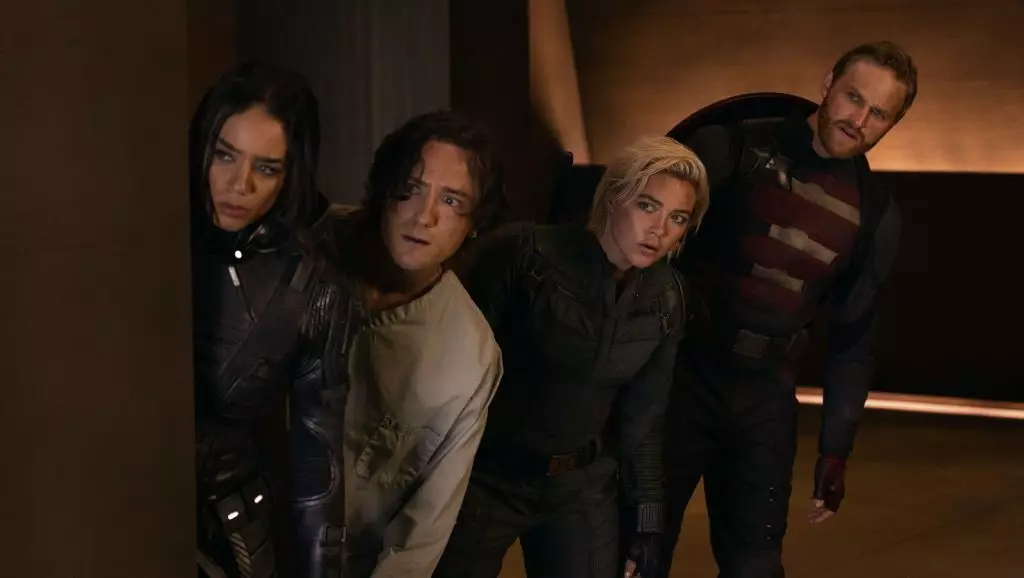One cannot help but notice the startling patterns emerging from the current cinematic landscape, especially notable is the mediocre performance of what many hoped would be a blockbuster—Disney and Marvel’s *Thunderbolts*. While the film is projected to gather an estimated $30 million in its second weekend, this figure represents a steep drop of approximately 60% from its debut. Such a decline reveals not just the film’s lackluster appeal but also raises broader questions about the viability of brand power in an oversaturated market. For all its star-studded cast and high-octane promises, *Thunderbolts* illustrates an unsettling truth: even a juggernaut like Disney cannot command the ticket sales it once did.
A Shifting Paradigm in Audience Expectations
Audiences are becoming ever more discerning, and Hollywood must adapt or die. The film industry’s reliance on established franchises and recognizability is becoming increasingly evident, yet this approach is proving ineffective. With films like *Sinners*, which continues to skyrocket with projected earnings near $200 million, it seems that originality and compelling storytelling hold more weight in the current cultural climate. Interestingly, *Sinners* has retained audience interest, showcasing that perhaps the era of simply slapping a well-known franchise on a mediocre script is over. The question must be asked: Are we witnessing the twilight of formulaic blockbusters, or is the draw of nostalgia simply too powerful to resist?
The Impact of Competition
Next weekend introduces fierce competition with New Line’s *Final Destination: Bloodlines*, anticipated to open between $30 million and $40 million. This influx of new players into the box office arena raises the stakes for *Thunderbolts* and its contemporaries, as summer blockbuster season approaches. The concern isn’t just about immediate revenue; it’s about sustaining interest and momentum. As cinemas brace for a potentially revitalizing season, the clock is ticking for films that cannot capture the zeitgeist or resonate with a diverse audience.
The Rise of Indie and Unique Narratives
On the underdog side of the spectrum, IFC’s *Clown in the Cornfield* is receiving rave reviews following its SXSW premiere and is shaping up to be a commercial sleeper hit. With a gritty premise established in a decaying Midwestern town, it reflects a creative resurgence that mainstream hits often lack. As audiences drive towards intriguing narratives, films that manage to tell an engaging story appear to be winning the emotional and financial investment of their viewers. Meanwhile, the behemoths of Hollywood seem stuck in a creative rut—churning out sequels and reboots devoid of relatable, refreshing content.
Box Office Results and Critical Reception: A Symbiosis
The phenomenon of box office success not being mirrored by critical acclaim is telling. Take *Shadow Force*, for instance—which looks to earn a mere $4 million—its potential failure is fueled by a 50% rating on Rotten Tomatoes. Critics have become more empowered in the age of digital reviews, often influencing audience decisions significantly. This dynamic can lead to films with substantial marketing budgets floundering simply because they fail to resonate emotionally or intellectually with both critics and viewers alike.
The interplay of ratings and ticket sales further implies a new era where quality must be prioritized to maintain financial success. In contrast, *Fight or Flight*, boasting a 78% positive reception, exemplifies that successful films respect their audiences and challenge them rather than pander via nostalgia or familiar tropes.
The Future Is Uncertain: Adapt or Perish
As the cinematic landscape shifts with each passing week and box office numbers fluctuate, the industry must recognize that audience demands are evolving. The key will lie in embracing creativity and prioritizing new voices over worn-out narratives. The success of exciting venues like *Fight or Flight* points towards a future where original stories may finally take precedence over franchise fatigue.
Disney and Marvel, quintessential powerhouses in the realm of cinema, are at a crossroads—either adapt to an audience that craves substance or risk losing their staunch foothold in an industry that thrives on innovation and engagement. The questions left hanging will taunt the industry: When will the giants recognize the shifting tides, or will they continue to plow ahead, blind to their vulnerabilities?

